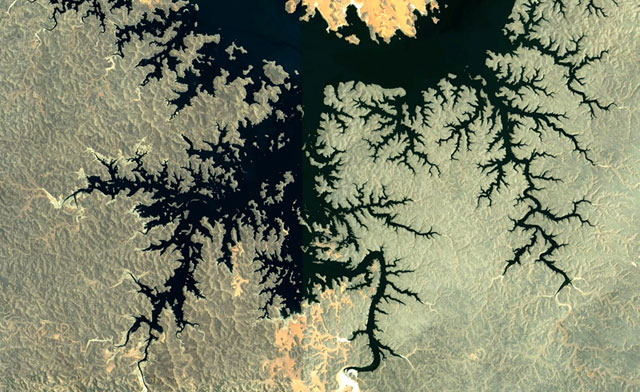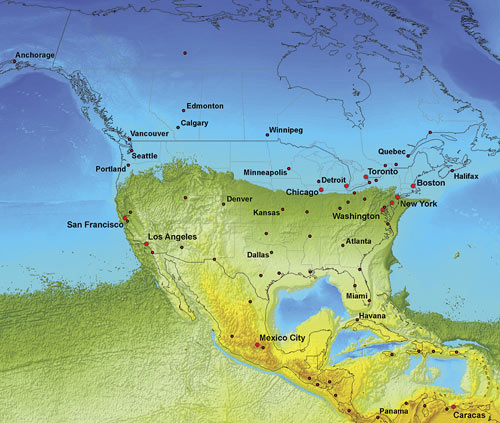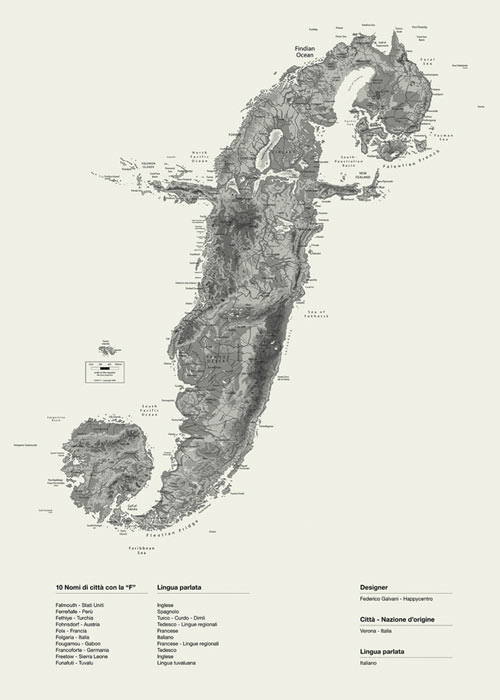A fractal tour of Earth
Paul Bourke has collected a bunch of images from Google Earth of natural features that display fractal patterns. This one, from Egypt, is flat-out amazing:

(via ★interesting)



This site is made possible by member support. 💞
Big thanks to Arcustech for hosting the site and offering amazing tech support.
When you buy through links on kottke.org, I may earn an affiliate commission. Thanks for supporting the site!
kottke.org. home of fine hypertext products since 1998.
Paul Bourke has collected a bunch of images from Google Earth of natural features that display fractal patterns. This one, from Egypt, is flat-out amazing:

(via ★interesting)
Using computer modeling, it’s possible to take a crack at answering that question.

If the earth stood still, the oceans would gradually migrate toward the poles and cause land in the equatorial region to emerge. This would eventually result in a huge equatorial megacontinent and two large polar oceans.
I like these Alphaposters by Happycentro, especially the gorgeous Lowercase F Island:

Because of fences, differing policies, or different cultures, national borders also mark habitat boundaries for animals and plants. More at Edible Geography.
For example, the antlion surplus in Israel can be traced back to the fact that the Dorcas gazelle is a protected species there, while across the border in Jordan, it can legally be hunted. Jordanian antlions are thus disadvantaged, with fewer gazelles available to serve “as ‘environmental engineers’ of a sort” and to “break the earth’s dry surface,” enabling antlions to dig their funnels.
Meanwhile, the more industrial form of agriculture practised on the Israeli side has encouraged the growth of a red fox population, which makes local gerbils nervous; across the border, Jordan’s nomadic shepherding and traditional farming techniques mean that the red fox is far less common, “so that Jordanian gerbils can allow themselves to be more carefree.”
Update: As this satellite view shows, the US-Canada border quite literally forms a line that cuts through the landscape. I had no idea this fenceless border was so visible. (thx, jonathan)
To get to a McDonald’s in the lower 48 United States, it’s never more than 145 miles by car. And the McFarthest Spot in the US is in South Dakota.
For maximum McSparseness, we look westward, towards the deepest, darkest holes in our map: the barren deserts of central Nevada, the arid hills of southeastern Oregon, the rugged wilderness of Idaho’s Salmon River Mountains, and the conspicuous well of blackness on the high plains of northwestern South Dakota.
See also maximum Starbucks density and Starbucks center of gravity of Manhattan.
Update: The distribution of McDonald’s in Australia is a bit more uneven. (thx, kit)
Update: As of December 2018, the point the farthest away from any McDonald’s in the lower 48 US states is in Nevada, 120 miles away from the nearest McDonald’s.
Though not as well known as the US version, Europe has a continental divide located between the Atlantic and the Mediterranean. It doesn’t run along the Alps as much as I thought it would.
BibliOdyssey has collected a number of charts which compare the heights of mountains and lengths of rivers by laying them all out next to each other. (Ok, kinda difficult to explain…just go take a look.) I had a chance to buy a copy of one of these maps a few years ago (not sure if it was an original print or what; it looked old) but passed it up because I didn’t have the money. Wish I would have bought it anyway. (via quips)
Forget the Red State / Blue State labels; the real question is Wal-Mart State or Starbucks State.
(thx, jason)
Click on world cities on a map to test your traveler IQ. Africa = nearly random clicking for me although I would have done better had I not misread Swaziland as Switzerland.
A plot of Japan’s Phillips curve (“a historical inverse relation and tradeoff between the rate of unemployment and the rate of inflation in an economy”) looks like Japan itself.
Detailed satellite photo of the northern polar ice cap showing that for the first time in recorded history, the Northwest passage (the orange line) is open to sea traffic. The passage was a subject of intense interest to the European powers from the late 1400s, who wanted to find a way to Asia by boat that didn’t involve sailing around Africa. (via ben)
Statetris: “Instead of positioning the typical Tetris blocks, you position states/countries at their proper location.” There are versions for the US, Africa, Europe, the UK, and more.
The Arctic Ocean was once more of a big lake that drained into the Atlantic Ocean. “18.2 million years ago, something happened. Drawn by shifting tectonic plates, the strait began to widen. Slowly, over the course of hundreds of thousands of years, salt water from the Atlantic began flowing into the Arctic turning it into the ocean we know today.”
Suck it, Nile! The Amazon River may now be the longest in the world.
Lake/island recursion, including “largest island in a lake on an island in a lake on an island”. It’s like matryoshka dolls except with islands and lakes. (via fimoculous)
How many countries can you name in 10 minutes? I got just over 70…my weak spots were Africa and spelling. And 10 minutes just isn’t enough time. See also name the 50 US states in 15 minutes.
The upper reaches of the northern hemisphere are warming so much that new islands are being discovered, including those once thought to be peninsula. “A peninsula long thought to be part of Greenland’s mainland turned out to be an island when a glacier retreated.”
Test yourself: how well can you pick out countries on a map of the world? I got a 59 my first time through…better than I thought I would do. (via plasticbag)
Heading into dinner last night, I believed with certainty that Finland was one of the Scandinavian countries. I rebuffed Mr. Jones’ attempts to disabuse me of that notion before dessert arrived, but it wasn’t until this morning that I checked into the matter and found that he may be correct.
The Minneapolis Star Tribune investigated the issue back in January, finding that there’s some controversy, even among the staff at the Finnish Embassy in Washington D.C.:
I called the Finnish Embassy in Washington, D.C., where press aide Mari Poyhtari started by saying Finland is part of Scandinavia, but then someone in the background disagreed and she corrected herself. The most accurate term is Fenno-Scandinavia or the Nordic countries, Poyhtari said. But, she admitted, “We always say we’re part of Scandinavia.”
The Wikipedia page on Scandinavia, the result of a vigorous discussion on the topic, indicates that there are several possible arrangements of Scandinavian countries, depending on the grouping criteria used and who you’re talking to.
So there you go, clear as mud. Probably best to avoid the issue altogether in the future by using the term Nordic instead of Scandinavian. All look same anyway.
Update: Underbelly notes that this “issue is in no way limited to Scandinavians”:
It’s the kind of muddiness you just have to expect when you consider any culture. Was Cleopatra an Egyptian? Are the Tasmanians British? What did the Byzanatines have in mind when they described themselves as “The Romans” while fighting wars against, well, Rome?
(thx, jack)
BLDGBLOG posts a series of maps showing how, through the movement of the earth’s tectonic plates, North America came to its present position and shape. Full set of maps here.
Update: Mike Migurski combined the maps into an awesome movie spanning 550 million years. It’s….wait for it…..the longest movie ever made!
The CIA World Factbook maintains a page about the entire world, which seems like it was meant to be read by aliens about to visit Earth for the first time. (thx jake)
Animated geographic history of the United States. This is pretty cool.
PBS to air three part series on Jared Diamond’s Guns, Germs, and Steel.
Stay Connected